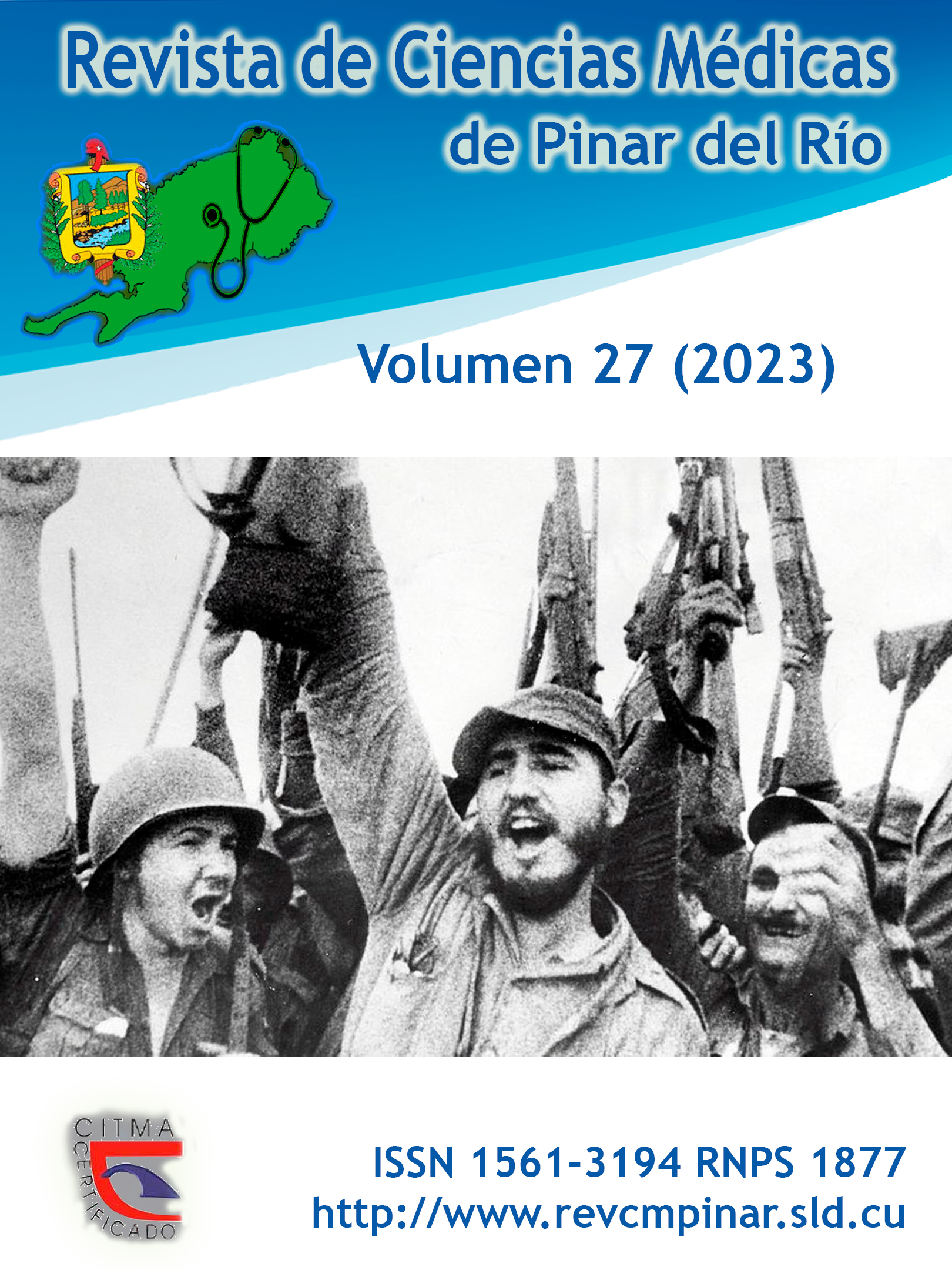Educational intervention on arterial hypertension in workers with risk factors
Keywords:
ARTERIAL HYPERTENSION, RISK FACTORS, EDUCATIONAL INTERVENTION.Abstract
Introduction: Hypertension is a chronic non-communicable disease, and a risk factor, to morbidity and mortality due to cardiovascular diseases.
Objective: Modify level of knowledge about arterial hypertension in workers with risk factors at schools in Villa Nueva and Sanfield.
Method: A quasi-experimental study of an educational intervention type on arterial hypertension in workers with risk factors was carried out in schools from November 2020 to March 2021. The population was 230, and the sample 115, through purposive sampling. Descriptive statistic was used with absolute frequency and percentage calculation.
Results: About the educational level, the university finished prevailed. About the knowledge about definition, before the intervention, 46,09 % had inadequate answers, then was 6,96 %, about risk factors, there were 51 with inadequate answers, then, only three. About healthy lifestyles, there were 63 inadequate answers before, which was reduced to five. Regarding clinical manifestations, 43,48 % did not know them, then all answered correctly. Only 10 people knew about the minimum check-up frequency, which was modified after. In terms of complications, before only 22 gave an inadequate response, which decreased to three.
Conclusions: It was possible that the workers with risk factors to develop the disease, dominate the aspects to prevent its appearance.
Downloads
References
1. Arredondo Bruce AE, Martínez Chávez S, González de la Cruz Y, Trench Rodríguez L. Análisis de la no adherencia al tratamiento en el paciente hipertenso. Rev. Médica Electrón [Internet]. 2018 may. –jun [citado 23/01/2021]; 40(3): 615-626. Disponible en: https://revmedicaelectronica.sld.cu/index.php/rme/article/view/1888
2. Alfonso Prince JC, Salabert Tortoló I, Alfonso Salabert I, Morales Díaz M, García Cruz D, Acosta Bouso A. La hipertensión arterial: un problema de salud internacional. Rev. Médica Electrón [Internet]. 2017 jul. –ago. [citado 23/01/2021]; 39(4): 987-994. Disponible en: https://revmedicaelectronica.sld.cu/index.php/rme/article/view/2091
3. Troche Valdés M, Estrada Padrón M, Quevedo Martínez M. Hipertensión arterial, enemigo silencioso de los adolescentes. Rev. Ciencias Médicas Pinar del Río [Internet]. 2018 [citado 23/01/2021]; 22(3): 466-475. Disponible en: http://www.revcmpinar.sld.cu/index.php/publicaciones/article/view/3432/html
4. Espinosa Brito A. Hipertensión arterial: cifras para definirla al comenzar 2018. Rev. Finlay [Internet]. 2018 [citado 09/11/2021]; 8(1): 66-74. Disponible en: http://www.revfinlay.sld.cu/index.php/finlay/article/view/594
5. Gomero-Cuadra R, Francia-Romero J. La promoción de la salud en el lugar de trabajo, una alternativa para los peruanos. Rev. perú. med. exp. salud pública [Internet]. 2018 [citado 04/042021]; 35(1): 139-144. Disponible en: http://www.scielo.org.pe/scielo.php?script=sci_arttext&pid=S1726-46342018000100021&lng=es
6. Dupotey Hernández DR. Intervención educativa en la prevención de enfermedades cardiovasculares en comunidades urbanas. Revista Conrado [Internet]. 2021 [citado 02/01/2021]; 17(81): 363-7. Disponible en: https://conrado.ucf.edu.cu/index.php/conrado/article/view/1909
7. Menor Rodríguez M, Aguilar Cordero M, Mur Villar N, Santana Mur C. Efectividad de las intervenciones educativas para la atención de la salud. Revisión sistemática. Medisur [Internet]. 2017 Feb [citado 27/02/2021]; 15(1): 71-84. Disponible en: http://scielo.sld.cu/scielo.php?script=sci_arttext&pid=S1727-897X2017000100011&lng=es
8. Portillo Blanco A, Diez JR, Barrutia O, Garmendia M, Guisasola J. Diseño de una intervención educativa sobre la pandemia de la COVID-19 y las medidas de prevención. Rev. Eureka sobre Enseñ. Y div. De las Cien [Internet]. 2022 [citado 27/02/2021]; 19(1). Disponible en: https://revistas.uca.es/index.php/eureka/article/view/7755
9. Sánchez Villafañes D, Rodríguez González JL, Sánchez Reyes RM, Gómez Liriano FA, Coss Rodríguez E. Intervención educativa sobre hipertensión arterial en pacientes hipertensos. Revista Información Científica [Internet]. 2014 [citado 27/02/2021]; 85(3): 450-458. Disponible en: http://www.revinfcientifica.sld.cu/index.php/ric/article/view/1125
10. Garaundo Mesa CS. Asociación entre el nivel de conocimientos de la hipertensión arterial y la adherencia al tratamiento farmacológico en pacientes atendidos en consultorio externo de cardiología del Hospital Ventanilla de septiembre a noviembre 2017 [Tesis]. Lima, Perú; 2018. [citado 27/02/2021]. Disponible en: https://repositorio.urp.edu.pe/handle/URP/1312?show=full
11. Pérez Pupo RD, Rodríguez Lazo M. Nivel de conocimientos, sobre hipertensión arterial, de pacientes atendidos en un Centro de Diagnóstico Integral de Venezuela. Correo Cient. Méd [Internet]. 2015 [citado 23/01/2021]; 19(3): 406-417. Disponible en: http://scielo.sld.cu/scielo.php?script=sci_arttext&pid=S1560-43812015000300003
12. Puicón Centurión SR. El nivel de conocimientos sobre hipertensión arterial en adultos mayores en el Centro de Salud José Quiñones Gonzáles [Tesis]. Mayo – octubre 2019 [citado 27/02/2021]. Disponible en: http://repositorio.udch.edu.pe/bitstream/UDCH/567/1/T044_72631260_T.pdf
13. Córdova Angulo MG, Domínguez Criollo MJ. Asociación del conocimiento sobre hipertensión arterial y adherencia al tratamiento em pacientes del club de hipertensos del Centro de Salud No. 1 del Distrito Chambo – Riobamba 06D01 [Tesis]. Cuenca, Ecuador; 2019. [citado 27/02/2021]. Disponible en: http://dspace.ucuenca.edu.ec/handle/123456789/31972
14. García Pérez A, Sánchez García F, Rey Córdoba K, García Collado M, Barcelay Leyva FA. Hipertensión arterial. Conocimiento de los trabajadores de la Facultad de Ciencias Médicas de Guantánamo, Cuba, Rev. Inf. Cient [Internet]. 2014 [citado 27/01/2021]; 84(2): 228-237. Disponible en: http://www.revinfcientifica.sld.cu/index.php/ric/article/view/1009
15. Ramírez Tuya OM. Nivel de conocimientos sobre hipertensión arterial y el autocuidado del adulto mayor hipertenso de la Microred Chavín – Ancash 2018. [Tesis]. Lima, Perú; 2018. [citado 27/02/2021]. Disponible en: http://repositorio.uigv.edu.pe/handle/20.500.11818/3916
Downloads
Published
How to Cite
Issue
Section
License
Authors who have publications with this journal agree to the following terms: Authors will retain their copyrights and grant the journal the right of first publication of their work, which will be publication of their work, which will be simultaneously subject to the Creative Commons Attribution License (CC-BY-NC 4.0) that allows third parties to share the work as long as its author and first publication in this journal are indicated.
Authors may adopt other non-exclusive license agreements for distribution of the published version of the work (e.g.: deposit it in an institutional telematic archive or publish it in a volume). Likewise, and according to the recommendations of the Medical Sciences Editorial (ECIMED), authors must declare in each article their contribution according to the CRediT taxonomy (contributor roles). This taxonomy includes 14 roles, which can be used to represent the tasks typically performed by contributors in scientific academic production. It should be consulted in monograph) whenever initial publication in this journal is indicated. Authors are allowed and encouraged to disseminate their work through the Internet (e.g., in institutional telematic archives or on their web page) before and during the submission process, which may produce interesting exchanges and increase citations of the published work. (See The effect of open access). https://casrai.org/credit/



